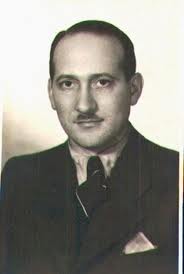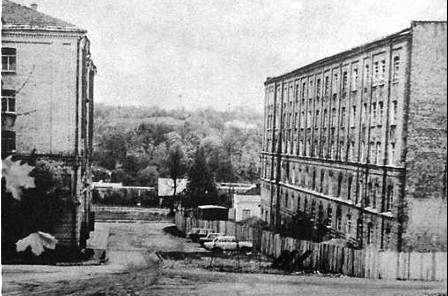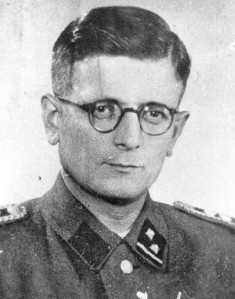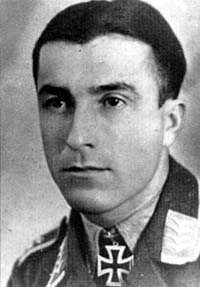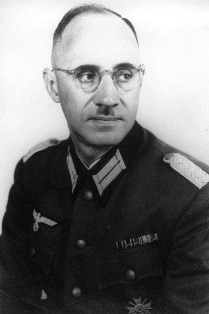Holocaust Education & Archive Research Team |
|
Trials Introduction to the Holocaust Trials
Trials
Interrogations & Testimonies
The IMT Series Nazi Justice | ||
The Testimony of Mosche (Moses) Feigenberg Testimony 2
This document represents testimony of Moses Feigenberg made as a deposition for the trial of Martin Weiss and other SS men in Germany in 1960
Translation from original German May 2001 [photos added to enhance the text]
Testimony of Mosche Feigenberg
First name of the father: Hirsch Address: Tel-Aviv, Sderot Ben-Zion 23, phone 26611 working place: Hospital Beer-Jaakow Year of birth: 1909 Place of Birth: District Wilna Profession: Urological Doctor Family: married Religion: Jewish
01.17.60, 5 pm in the apartment of the witness
Interrogator: 180 Sergeant Meir Warschawski
Through the force of article 2 (1) of the criminal-process-order I have written down the testimony of Mosche Feigenberg. Meir Waschawski 180 Sergeant
I lived in the city of Wilna at the beginning of WW2 and I worked as doctor for urinary illnesses. I have lived in this city about 40 years until my emigration to Israel.
In September of 1941 my family and I were forced to live in the ghetto together with all Wilna Jews. I worked at the Jewish hospital in the ghetto but also as worker outside the ghetto where I cleaned railroads and chopped wood at a place called Sorok Tatari.
One week before the liquidation of the Wilna ghetto in September of 1943 the Nazi administration sent about 1500 Jews from the ghetto into a working camp called HKP and about 1500 Jews in another working camp called Kailis. My family and I came into the HKP camp but the Nazis liquidated both camps at the beginning of July 1944. The liquidation was carried out under the command of the SS and the SD. That happened two weeks before the liberation of the city through the Red Army.
I want to remark that the two camps were located close to the city and that I worked as a Doctor in both of them. I had the opportunity to see all the actions the Gestapo and the SS carried out against the Jewish population, often with the help of the Lithuanian police. I was also there during the children's liquidation action on March 27th 1944.
I see eleven pictures in front of me (the witness examines 11 pictures that were sent here from Ludwigsburg, the witness takes the picture of Heinrich Schmitz's face). This picture reminds me of the man whose name I found out later was Heinrich Schmitz. About October 1943 a Jewish family composed of father, mother and a twelve years old daughter was caught when they tried to escape. They were brought back to the camp and hung in front of the public.
The whole camp population was ordered to see the execution. I remember that when the cord around the man's neck tore, he fell down still alive. He was crying and beseeched the SS man to let him alive. But this man didn't have mercy and he shot him instantly with his revolver.
The picture of Heinrich Schmitz that I see know corresponds with the identity of the man who shot the hung man. I remember that the SS man's face was handsome and fine, it was like the face of an actor. About around the time of this incident I often heard at the HKP camp administration that the SS man who was responsible for the Jews was called also Schmitz. He himself was responsible for all kinds of actions against the Jews. I myself saw him shooting the fallen down man.
He looks very much alike the picture of the Heinrich Schmitz that I see now. On march 27th 1944 when I was in the HKP camp I saw the liquidation action against Jewish children that was carried out by SS and SD under the personal leadership of Martin Weiss.
The goal of this action was the final and absolute liquidation of all children in the camp. The scared Jews began to hide their children in different hideouts, for example in stoves, in toilets, in barrels and under beds. But the Gestapo carried out a very exact examination of all homes. With the help of axes and hammers they searched the walls and got many children. They brought them all into the backyards to load them on big cars.
The number of children that the Nazis brought out of the camp to send them to an unknown location was about 250. They never came back again. We were lucky enough to hide about a dozen children. I myself brought eight kids into a hideout that I prepared, including my own twelve years old daughter whom I hid in a potato sack. Six out of the eight kids I saved during the liquidation action were brought later also to unknown locations.
I as the camp doctor had the right to walk in the backyards and so I was able to see the whole details of the action. I remember a woman called Zukowska who didn't want to separate herself from her daughter. She was lead away some meters from the backyard and shot personally by Martin Weiss. Of all the pictures here I recognize also the one that shows Max Gross whom I saw often in the ghetto as well as in the HKP camp. He participated each Sunday in the count of the forced workers during the roll call. He also participated in the children action like many other Gestapo and SS men.
They all searched for hidden children and were equipped with axes and iron sticks. I often heard his name from the Jewish leader of the camp Kollisch and the Jewish camp policemen. I also know that on the same day, March 27th 1944 a similar action took place in the other camp called Kailis. There also Jewish children were liquidated.
Both camps, HKP and Kailis, were finally liquidated on July 2nd 1944 when all the remaining Jews were brought to a place called Ponari from where they never returned. Some hundred Jews who hid themselves in different places were found and murdered by the Gestapo and SS. There remained only a few dozen who couldn't be found by the Germans. Some of those few lucky people were the members of my family. A large number of SS and Gestapo members participated in the liquidation of both camps, one of them that I remember was Boehme, whom I saw also a few times before in the HKP camp.
He was a fat man with a round face, about 35 years old. I immediately recognized him from the picture. During the last action I was hidden behind a window and so I was able to see all the Nazis who came into the backyard. One of them was Boehme. From all the other pictures I see here I know those showing Richard Schweizer and Gerhard Kortkampf. Until now I've never heard their names before but I saw them during different actions in the ghetto of Wilna and at the ghetto's entrance.
I also know that a swarm leader called Richter and a SS man called Rab were responsible for the working camps HKP and Kailis and that they also carried out the weekly roll calls of the camp populations. I knew Richter even personally. I spoke several times with him. He was a skinny man with a long neck and the camp workers gave him the nickname "Goloszeika".
He was responsible for the capture of Jews during actions and their sending to a place called Koztova Ruda, where they had to work in peat bogs. Only few of them survived. I also remember personally a SD man called Kittel. He participated in a great number of actions in the Wilna ghetto as well as in both camps. He was known as a very cruel and sadistic man. I often saw him raping Jewish women. I remember an incident in October of 1943. Back then Kittel brought 20 Jewish women into a closed car and sent them to Ponari for liquidation. He did this to scare camp prisoners who thought about the possibility of escaping because some attempts happened in the last time.
The driver of that car was a Wehrmacht soldier called Beck who told later that the women smashed a window during the ride and that most of them sprang out of the car and fled. It is true that a part of the women were brought back to the camp.
(the paper stops here, the next paper doesn't continue this story !)
I want to add that the workers' camp HKP belonged administratively to the engineers of the German army. It was under the authority of the commander of an engineers unit, Major Plagge. The camp workers built generator gas cars, that replaced fluid petrol cars. Major Plagge was a correct man despite his membership of the Nazi party. He helped us and protected us at numerous opportunities. At the eve of the camp liquidation he warned us about the coming event.
In 1948 when I was in the German city Munich, I received a letter from him. He wrote how happy he was to hear about my survival and asked me to visit him because he described himself as a sick and lonely man. I know that he lives in Darmstadt. He worked at the pharmaceutical business Merck.
Major Plagge was in continuous relation with the SS and SD people and I am sure that he knows them all very well and is ready to give evidence about the incidents that had happened in Wilna. Major Plagge's aide-de-camp was a Wehrmacht soldier called Zehe who lives today in the Bogenstrasse in Coblence.
I wrote a paper in Yiddish that appeared in 1946 in Landsberg with the title "Wilna unterm Nazijoch" ("Wilna under Nazi yoke") in Latin script. This paper is now in my hand and I use it to refresh my memory about that unlucky time.
This paper was being read to me and I testify that it is a correct writing down of my testimony made in Hebrew.
Dr. Mosche Feigenberg
The following are translated fragments from the “Vilna under the Nazi Yoke” document which Dr. Feigenberg originally made in Landsberg Germany in 1946
Testimony of Dr. Moses Feigenberg Historical commission in Landsberg Wilne under Nazi Oppression as told by Moses Feigenberg recorded by Moshe Waisberg single publication Landsberg November 1946 Translated from transliterated Yiddish by Pearl Good
Excerpts:
Page 23
The HKP camp was established on September 17th, 1943 and had employed up to 1500 workers (families included). At the beginning of September 1943, the chief of HKP, Major Plagge, found out that the Ghetto of Wilno would be soon liquidated. He was a cultured and benevolent man who wanted to rescue his Jewish workers. Thus he then organized a work-camp for his workers, named Jewish Work- Camp HKP. He established the camp in the two big Jewish buildings on Subocz 37.
Page 32
The month of July was arriving. Up to 1500 Jews who were still in the HKP camp were entirely cut off, they were not let out for any work and received no provisions. The Guard around the camp was much strengthened. One could not even think of getting out. Everybody was looking for a hiding-place inside the camp. The word "Malina" was passing from mouth to mouth. Everyone could only be sitting, waiting for a miracle....
On one of those horrible days Major Plagge, the Chief of HKP, appeared in the yard of the camp . In the presence of (SS) Obersharfuerer Richter, Plagge made a speech to the Jews. He explained that these were difficult times for the German Army. It was not out of the question that the camp might not have to evacuate. He comforted the Jews that he might possibly go with them. But his speech brought no assurance, to the contrary, it made them sure that their end was near
Sources: Transcripts from Marcus Schneider with grammatical editing by Michael Good Lexikon der Gerechten unter den Völkern: Deutsche und Österreicher, By Israel Gutman, Daniel Fraenkel, Jacob Borut The Holocaust in Lithuania - Dina Porat - The Final Solution - Origins and Implementation - David Cesarani (Ed) - Routledge, London 1996 Yad Vashem
Copyright. Dr. Martin Friedhaus H.E.A.R.T 2011
|
